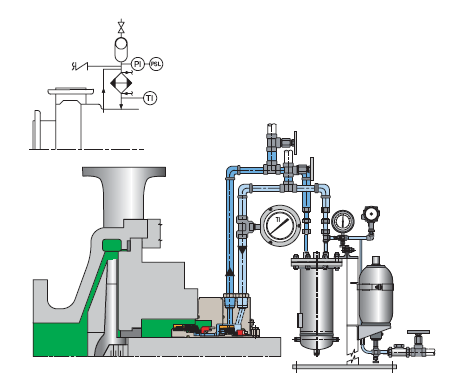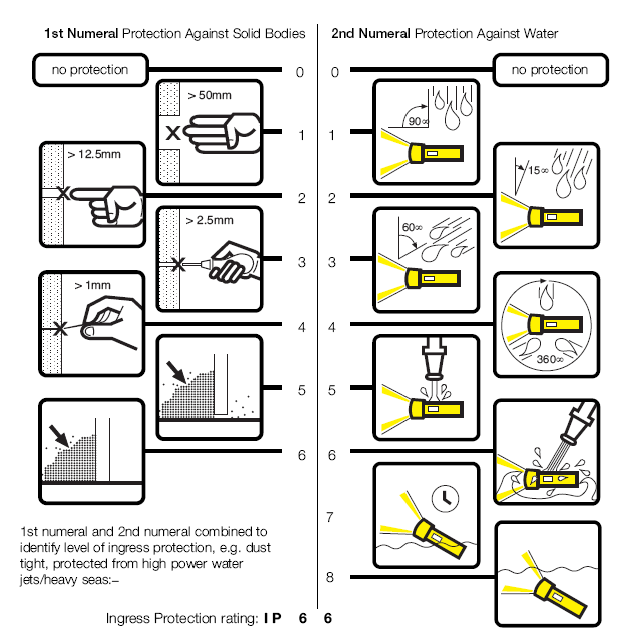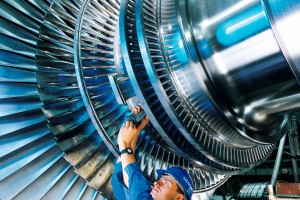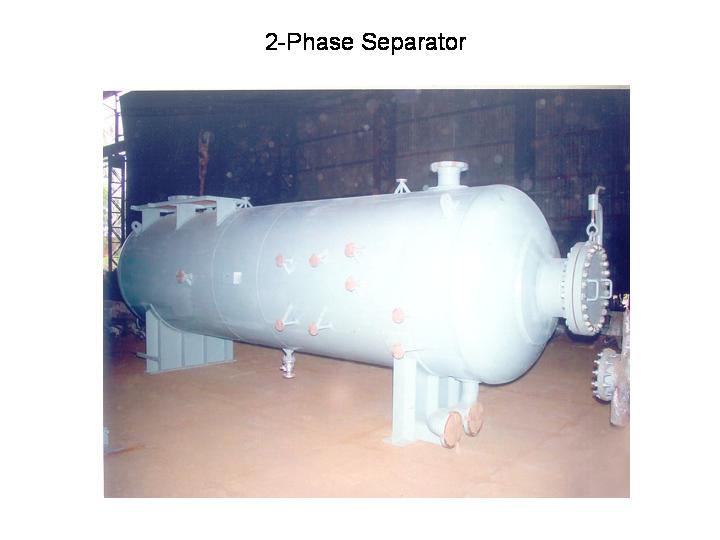Pump cavitation occurs when the absolute pressure on the liquid falls below the liquid’s vapor pressure. Cavitation in pumps can damage various pump parts such as mechanical seals, bearings, pump impeller, driver shaft alignment etc. This post contains a brief discussion about the causes of cavitation, effects of cavitation, types of cavitation and how to prevent cavitation in pumps.
Table of content:
What is cavitation in pumps?
Centrifugal Pump Cavitation
What causes cavitation in pumps?
Effects of cavitation in pumps
Types of cavitation in pumps
How to prevent pump cavitation
What is cavitation in pumps?
Pump cavitation is the formation and subsequent collapse or implosion of vapor bubbles in a pump. It occurs when gas bubbles are formed in the pump due to drop in absolute pressure of the liquid below vapor pressure. These gas bubbles occupy space inside the pump and affect the pump's operating pressure and flow.
With vapor bubbles in the low-pressure zones of the pump, the motor's energy is wasted expanding the bubbles instead of bringing more liquid into the pump. As the bubbles pass into the pump's high-pressure zones, the motor's energy is wasted compressing the bubbles instead of expelling the liquid from the pump.
The bubbles can collapse as they pass from low- to high-pressure zones in the pump. When vapor bubbles collapse inside the pump the liquid strikes the metal parts at the speed of sound. The noise generated from these collisions of gas bubbles into the metal parts of pump sounds like pumping marbles and stones.
Cavitation of a pump can be a serious obstacle to smooth operation of a centrifugal pump. Therefore it is important to understand different pump cavitation causes in order to understand how to prevent pump cavitation.
Centrifugal Pump Cavitation
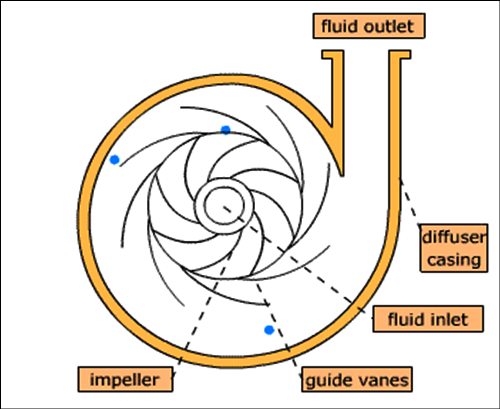
Centrifugal pump is designed as a hydraulic machine to move liquids. Cavitation or entrained gas causes problems in pump performance. Pump cavitation is caused by vaporization of the liquid in pump suction due to several reasons. Experiments claim that a volume of only one per-cent air will cause a loss of head and efficiency. Pump cavitation can damage the pump impeller blades and frequent dry running of pumps can damage other pump parts.
What causes cavitation in pumps?
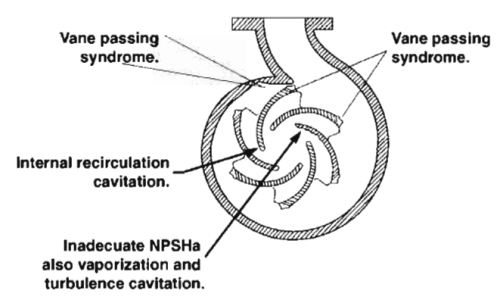
Drop in pressure at the suction nozzle due to low NPSHa
If the fluid at pump suction is not available sufficiently above the vapor pressure of liquid at operating conditions, then vaporization of liquid and formation of gas bubbles is very likely, leading to cavitation.
Cavitation of pump due to vaporization
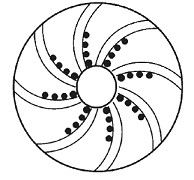
It’s called “classic Cavitation”. According to Bernoulli’s Law, when velocity goes up, pressure goes down. Centrifugal pump works by acceleration and imparting velocity to the liquid in the eye of the impeller. Under the right conditions, the liquid can boil or vaporize in the eye of the impeller. When this happens we say that the pump is suffering from vaporization cavitation. This type of cavitation is also called inadequate NPSHa cavitation. To prevent this type of cavitation, the NPSHa in the system (the available energy in the system), must be higher than the NPSHr of the pump (the pump’s minimum energy requirement).
Cavitation by internal circulation
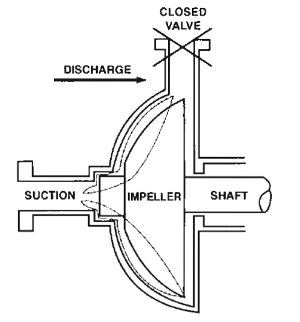
This is a low flow condition where the discharge flow of the pump is restricted and the product cannot leave the pump. The liquid is forced to re-circulate from high-pressure zones in the pump into low-pressure zones across the impeller. This type of cavitation originates from two sources. First, the liquid is circulating inside the volute of the pump at the speed of the motor and it rapidly overheats. Second, the liquid is forced to pass through tight tolerances at very high speed the heat and the high velocity cause the liquid to vaporize.
Click the button to learn more about pump recirculation.
Cavitation by vane passing syndrome
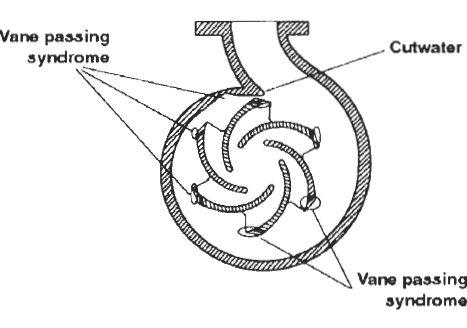
The free space between the impeller blade tips and the cutwater should be 4% of the impeller diameter
This is caused by use of a larger diameter impeller or from re-metalizing or coating the internal housing of the pump. Free space between the impeller blade tips and the cutwater should be at least 4% of the impeller diameter. For smaller spaces, the liquid velocity between these spaces becomes very high. This high liquid velocity leads to low pressure, heating, bubble formation and hence cavitation.
With the pump disassembled the damage is seen on the blade tips at the OD of the impeller and just behind the cutwater on the internal volute wall.
Pump cavitation due to air aspiration
Air can be drawn into the piping and pump from diverse forms and different points. Air can enter into the piping when the pump is in vacuum, through following routs -
- Through pump shaft packing.
- Valves stem packing on valves in the suction piping.
- Joint rings on suction piping.
- Flange faces sheet gaskets at pipe joints.
- O-rings and threaded fittings on instrumentation in the suction piping.
- O-rings and other secondary seals on single mechanical seals.
- The faces of single mechanical seals.
- Air can also enter into the pump from bubbles and air pockets in the suction piping.
- Liquids that foam can introduce air into the pump.
Increase of the temperature of the pumped liquid
Increase in liquid temperature at the pump suction point increases the vapor pressure of the liquid. Thus it becomes more likely for operating pressure to fall below this vapor pressure limit, hence leading to bubbles and cavitation.
Increase in the fluid velocity at pump suction
Increase in fluid velocity at pump suction can typically be caused by higher liquid flowrates than the design case. As per Bernoulli’s principle, higher liquid velocity means higher velocity and lower pressure head. Frictional pressure drop in the pump suction also rises with rise in the flowrate, making low pressure and cavitation at pump suction more likely to occur.
Reduction of the flow at pump suction
Certain minimum flow is required by the centrifugal pumps to keep them from running dry, as indicated by the pump curves. If liquid flow falls below this limit, possibility of developing vapor in pumps and cavitation increases.
Pump cavitation due to turbulence
Turbulent flow leads to formation of vortexes in pump suction. Inadequate piping, sharp elbows, restrictions, filters and strainers in suction line contribute to turbulence. The waterfall effect in suction vessels is another contributing factor to pump turbulence.
The pump is not selected correctly
Every centrifugal pump has a certain requirement of positive suction head (NPSHr). If the pump is not selected properly NPSHa might fall below this NPSHr limit, causing cavitation.
Effects of cavitation in pumps
Pump cavitation causes noise and vibration. If the pump operates under cavitation conditions for a long time, the following damage can occur. Let's look at possible pump cavitation damage. These problems won’t go away until you resolve cavitation at its source.
Damage to pump mechanical seal
Mechanical seal are very important in any pumps as they prevent any foreign materials from entering into the pump casing and the pumped liquid to escape to the environment so any damage that may occur to the mechanical seal will increase operating cost and consumption of natural resources. Cavitation can badly affect the performance of the mechanical seal as it will cause damage to the seal faces and if the cavitation phenomena continues the seal may run dry without continues cooling or lubrication.
Damage to pump shaft alignment
Shaft miss-alignment can occur after pump operation due to many reasons but the most important one is the vibration that may be caused due to cavitation and expansion of pump shaft due to heat generated in the pump due to cavitation.
Damage to Bearings
The bearing life will decrease significantly due to the vibration which will be transmitted from the pump casing to the bearing housing, the vibrations cause the balls and rollers to jam into the raceways causing the very small bents the races will appear like a corduroy cloth
Pump Impeller damage
When pressure in the eye of the impeller falls below the vapor pressure of the fluid, then cavitation can begin and gas bubbles are formed the bubbles can collapse as they pass from low- to high-pressure zones in the pump. When vapor bubbles collapse inside the pump the liquid strikes the metal parts at the speed of sound. The noise we hear from outside the pump when we say that cavitation sounds like pumping marbles and rocks.
Types of cavitation in pumps
It is important to look at different types of pump cavitation and its causes, before looking at how to prevent it.
- Vaporization cavitation, also called inadequate NPSHa cavitation.
- Internal re-circulation cavitation.
- Vane passing syndrome cavitation.
- Air aspiration cavitation.
- Turbulence cavitation.
How to prevent pump cavitation
Now let's look at how the pump cavitation and associated damage can be prevented.
How to prevent cavitation due to vaporization
NPSHa > NPSHr + 3 ft or more safety margin
- Lower the temperature.
- Raise the liquid level in the suction vessel.
- Change the pump.
- Reduce motor RPM if possible.
- Increase the diameter of the eye of the impeller.
- Use an impeller inducer.
- Use two lower capacity pumps in parallel.
- Use a booster pump to feed the principal pump.
Prevent cavitation of pump due to internal circulation
This condition cannot be corrected on pumps with an enclosed impeller.
- You need to open the restricted discharge valve on the pump.
- The problem could be a clogged downstream filter.
- A closed discharge valve.
- An over-pressurized header.
- Check valve installed backwards
- Operating the pump at or close to shut-off head.
Prevent vane passing related cavitation
To prevent damage due to such cavitation, free space between the impeller blade tips and the cutwater should be at least 4% of the impeller diameter. For example, for a 10” impeller, the free space should be 4% of the impeller diameter between the blade tips and the cutwater. 10” x 0.04 = 0.4”.
Prevent air aspiration led cavitation
- Tighten all flange faces and gaskets.
- Tighten all pump packing rings and all valve stem packing on suction piping.
- Keep the velocity of the fluid in the suction piping at less than 8 ft per second. It may be necessary to increase the diameter of the pipe.
- Consider using dual mechanical seals with a forced circulation barrier fluid.
Prevent cavitation due to excess turbulence in suction line
- Design the pump suction piping and routing to avoid excess turbulence.
- Take precaution while fixing the pump suction line size to avoid turbulence and have sufficient NPSHa.
- Respect the maximum allowable flow limit of the pumps.

